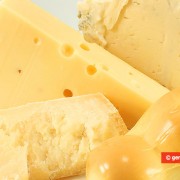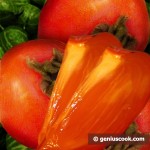Kiwi
 Kiwifruit is a high climber plant with beautiful white and pink flowers resembling the rose. Its fruits have a very thin peel and a flesh with rows of small black seeds inside. Kiwifruit appeared about hundred years ago. It was named after a little bird kiwi, which, though it has a long beak, absolutely cannot fly, and outwardly resembles this fruit covered with thick green-brown skin. Sometimes kiwifruit is called Chinese gooseberries or sheep peach.
Kiwifruit is a high climber plant with beautiful white and pink flowers resembling the rose. Its fruits have a very thin peel and a flesh with rows of small black seeds inside. Kiwifruit appeared about hundred years ago. It was named after a little bird kiwi, which, though it has a long beak, absolutely cannot fly, and outwardly resembles this fruit covered with thick green-brown skin. Sometimes kiwifruit is called Chinese gooseberries or sheep peach.
The History of the Kiwifruit
At the beginning of the previous century English gardener Ellison after having received the seeds of the Chinese peach started improving this plant. The process had lasted three decades until there was a small bush with fruits, which are called now kiwi, or kiwifruits. Kiwifruit grew unpretentious, yielded well, was stored well in inappropriate conditions for several months. Kiwifruit now grows all over the world in warm countries. Kiwifruits are ripe, when you feel them a little soft, when pressing a finger on them. The tastiest kiwifruits are the fresh ones. They are normally eaten either peeled and cut or cut half-and-half across to get two small cups. It can be eaten just with a spoon from the hairy natural cup.
Health Benefits of Kiwifruit
These fruits are very tasty, they are also good for digestion, because they contain a lot of vitamin C and magnesium, which regulates the cellular metabolism, stimulates the organism resistance to stress, in addition it burns fats, it’s not for nothing that there are so many diets including kiwifruit.
Healthy Substances in Kiwifruit
Kiwifruit contains sugar, organic acids, pectines, cellulose, flavonoids, phosphorus, beta-carotene, folic acid. A kiwifruit contains two times more vitamin C than an orange does. Kiwifruits protect the organism from infections, strengthen immune system. Together with magnesium vitamin C supports the cardiac function. Additional to the listed above kiwifruit contains vitamins A, D, Е, В2, В3, В6, a lot of potassium; a kiwifruit weighing about 150 gram contains a lot of magnesium and is a source of iron, which makes it extremely healthy. Kiwifruit also contains actinidine, which improves the protein digestion. Nutritionists consider kiwi to have an ideal balance of the minimum of calories and the maximum of health benefits, but don’t forget that kiwi abuse can cause allergy.
Kiwifruit Is a Vitamin Bomb
Doctors consider kiwifruit a real vitamin bomb, because it contains a lot of healthy components. This hairy green ball is especially rich in vitamin C, like no other fruit. One kiwifruit contains a daily norm of an adult of vitamin C, and this is approximately 250 milligrams. By the way, if you eat one kiwi every day, you will provide your organism with vitamin C in full. Why do you need it? Look here, why.
- Vitamin C actively participates in the metabolism.
- It strengthens blood vessels and immune system.
- It improves the organism resistance to various infections.
- It also improves eyesight.
- Vitamin C stimulates the capacity for work.
- It helps to manage stress.
- It contains a lot of magnesium, which provides a healthy heart function.
- The fruit is also rich in mineral salts, in particular potassium.
- It also contains cellulose, which, as is well known, helps in excess cholesterol excretion and digestion normalization.
The Effect of Eating Kiwifruit on Health
In general kiwifruit refers to the kind of fruits reducing the risk of oncological and cardiovascular diseases, such as coronary insufficiency and hypertension. It is also well known, that vitamins and organic acids contained in tropical fruits are very healthy for the face skin: they have both tonic and curing effect, make the skin more elastic, toned up and young. But kiwifruit is especially efficient. This fruit perfectly cleans the skin and at the same time provides it with a whole complex of vitamins. This magic fruit is widely used in cosmetics, in various masks and creams.







